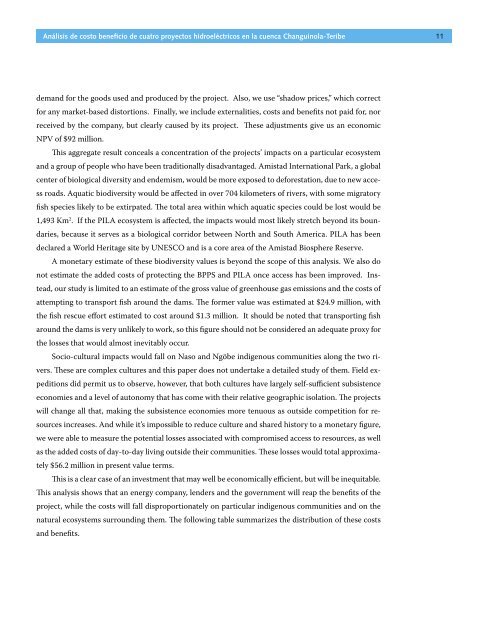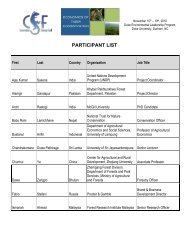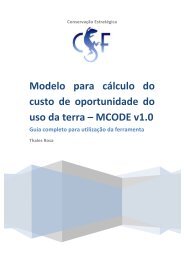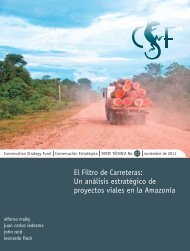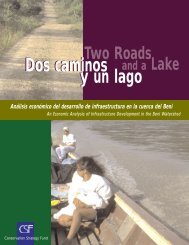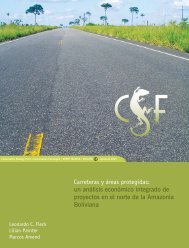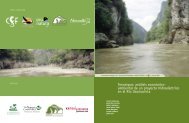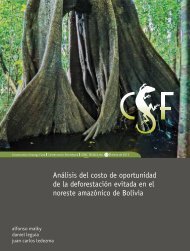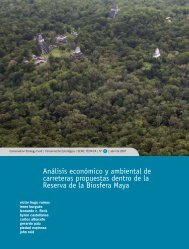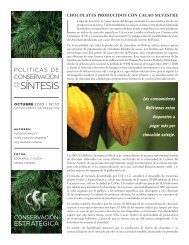Análisis de costo beneficio de cuatro proyectos - Biblioteca Nacional ...
Análisis de costo beneficio de cuatro proyectos - Biblioteca Nacional ...
Análisis de costo beneficio de cuatro proyectos - Biblioteca Nacional ...
- No tags were found...
Create successful ePaper yourself
Turn your PDF publications into a flip-book with our unique Google optimized e-Paper software.
<strong>Análisis</strong> <strong>de</strong> <strong>costo</strong> <strong>beneficio</strong> <strong>de</strong> <strong>cuatro</strong> <strong>proyectos</strong> hidroeléctricos en la cuenca Changuinola-Teribe 11<strong>de</strong>mand for the goods used and produced by the project. Also, we use “shadow prices,” which correctfor any market-based distortions. Finally, we inclu<strong>de</strong> externalities, costs and benefits not paid for, norreceived by the company, but clearly caused by its project. These adjustments give us an economicNPV of $92 million.This aggregate result conceals a concentration of the projects’ impacts on a particular ecosystemand a group of people who have been traditionally disadvantaged. Amistad International Park, a globalcenter of biological diversity and en<strong>de</strong>mism, would be more exposed to <strong>de</strong>forestation, due to new accessroads. Aquatic biodiversity would be affected in over 704 kilometers of rivers, with some migratoryfish species likely to be extirpated. The total area within which aquatic species could be lost would be1,493 Km 2 . If the PILA ecosystem is affected, the impacts would most likely stretch beyond its boundaries,because it serves as a biological corridor between North and South America. PILA has been<strong>de</strong>clared a World Heritage site by UNESCO and is a core area of the Amistad Biosphere Reserve.A monetary estimate of these biodiversity values is beyond the scope of this analysis. We also donot estimate the ad<strong>de</strong>d costs of protecting the BPPS and PILA once access has been improved. Instead,our study is limited to an estimate of the gross value of greenhouse gas emissions and the costs ofattempting to transport fish around the dams. The former value was estimated at $24.9 million, withthe fish rescue effort estimated to cost around $1.3 million. It should be noted that transporting fisharound the dams is very unlikely to work, so this figure should not be consi<strong>de</strong>red an a<strong>de</strong>quate proxy forthe losses that would almost inevitably occur.Socio-cultural impacts would fall on Naso and Ngöbe indigenous communities along the two rivers.These are complex cultures and this paper does not un<strong>de</strong>rtake a <strong>de</strong>tailed study of them. Field expeditionsdid permit us to observe, however, that both cultures have largely self-sufficient subsistenceeconomies and a level of autonomy that has come with their relative geographic isolation. The projectswill change all that, making the subsistence economies more tenuous as outsi<strong>de</strong> competition for resourcesincreases. And while it’s impossible to reduce culture and shared history to a monetary figure,we were able to measure the potential losses associated with compromised access to resources, as wellas the ad<strong>de</strong>d costs of day-to-day living outsi<strong>de</strong> their communities. These losses would total approximately$56.2 million in present value terms.This is a clear case of an investment that may well be economically efficient, but will be inequitable.This analysis shows that an energy company, len<strong>de</strong>rs and the government will reap the benefits of theproject, while the costs will fall disproportionately on particular indigenous communities and on thenatural ecosystems surrounding them. The following table summarizes the distribution of these costsand benefits.


